Eel River Ecology – Algae
Flow and climate thresholds for algal assemblages in the Eel River
Algae are foundational energy sources for food webs in sunlit rivers. Many (like most diatoms) are highly edible and fuel summer growth for fish and macroinvertebrates. Other algal taxa, however, are inedible or even toxic (harmful 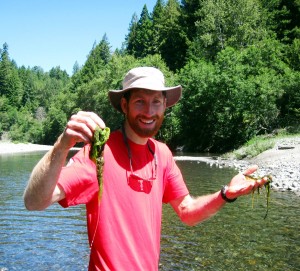 algae bloom, HAB) degrading aquatic habitats, water quality, and creating public health hazards. Keith Bouma-Gregson is working towards identifying threshold conditions that tip healthy algal assemblages into harmful algal blooms in the Eel, and similar rivers. He has partnered with the Eel River Recovery Project (ERRP, www.eelriverrecovery.org) to develop a citizen science algal monitoring program for the Eel. Keith has also collaborated with Raphael Kudela, UC Santa Cruz, to deploy Prof. Kudela’s cyanotoxin monitoring SPATT samplers throughout
algae bloom, HAB) degrading aquatic habitats, water quality, and creating public health hazards. Keith Bouma-Gregson is working towards identifying threshold conditions that tip healthy algal assemblages into harmful algal blooms in the Eel, and similar rivers. He has partnered with the Eel River Recovery Project (ERRP, www.eelriverrecovery.org) to develop a citizen science algal monitoring program for the Eel. Keith has also collaborated with Raphael Kudela, UC Santa Cruz, to deploy Prof. Kudela’s cyanotoxin monitoring SPATT samplers throughout

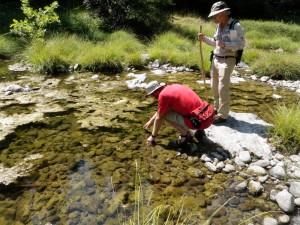
the South Fork and mainstem Eel River during summer base flow. At several sites, they detected the cyanobacterial neurotoxin, anatoxin-a. Starting in since 2002, this toxin has been implicated in the deaths of several dogs after they swam in the Eel River. Keith complements his basin-scale monitoring with local experiments and detailed monitoring of local proliferation and spread of cyanobacterial infestations. As summer flows subside, incipient growths of the potentially toxic cyanobacterium Anabaena spp. start to develop as epiphytes on senescent spires of Cladophora glomerata. Keith monitors and experimentally manipulates light, temperature, nutrients, and flow velocities to understand conditions that allow toxic cyanobacteria to overgrow and dominate the more ‘normal’ edible assemblages of diatoms that cover rocks and surfaces of green macroalgae. Where and when can changing environmental conditions flip edible algal assemblages to assemblages dominated by inedible or harmful algae?
Some climate change scenarios predict larger winter floods and drier summers, which would favor cyanobacteria proliferations. Anthropogenic water withdrawals further depress summertime river discharges, also increasing the likelihood of cyanotoxin production. Knowledge of thermal, solar radiation, and flow regimes that promote cyanobacteria is needed for management to sustain a fish-bearing food web and reduce public health hazard from cyanotoxins. Keith was formerly a PhD student advised by Mary Power in the Integrative Biology department at UC Berkeley, and a postdoc with Jill Banfield in the Earth and Planetary Sciences department at UC Berkeley. He is now the CA Freshwater Harmful Algal Blooms Program Lead at the CA State Water Resources Control Board.
Tracing linkages and thresholds of food webs and ecosystems through Eel drainage networks
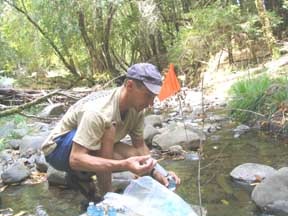
Dr. Jacques Finlay is a Professor in the College of Biological Sciences at the University of Minnesota. Jacques and his students and colleagues investigate how organisms and environments interact with biogeochemical fluxes, cycles, and transformations. He has used innovative isotope techniques to trace the sources and fate as of solutes transported by rivers, and their exchange between channels and surrounding watersheds. Jacques’ work on how flow and longitudinal changes in photosynthetic demand systematically altered stable 13C enrichment of algae paved the way for better resolution of the importance of algal versus terrestrial carbon sources for 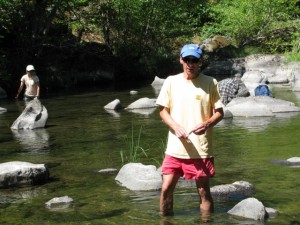 consumers in rivers. He has also detected and quantified changes in nitrogen isotopes that correspond to a longitudinal and seasonal increase in cyanobacterial nitrogen fixation in the Eel. He detected an abrupt threshold where watershed areas exceeded 100 km2, where light availability allowed increasing photosynthesis and nitrogen fixation by benthic algal assemblages, which in turn altered stream-water N concentration and N:P ratios and stoichiometry in larger streams and mainstem rivers. Jacques work has also given us glimpses of the spatial dimensions of food web interactions–organisms that co-occur within mm of each other may actually feed from different “resource sheds”. Recently, he has expanded his isotope analysis to use deuterium, and has collaborated with his former student Martin Tsui to use the strange, multiple isotopes of methyl mercury to trace energy exchange between channels and surrounding forests.
consumers in rivers. He has also detected and quantified changes in nitrogen isotopes that correspond to a longitudinal and seasonal increase in cyanobacterial nitrogen fixation in the Eel. He detected an abrupt threshold where watershed areas exceeded 100 km2, where light availability allowed increasing photosynthesis and nitrogen fixation by benthic algal assemblages, which in turn altered stream-water N concentration and N:P ratios and stoichiometry in larger streams and mainstem rivers. Jacques work has also given us glimpses of the spatial dimensions of food web interactions–organisms that co-occur within mm of each other may actually feed from different “resource sheds”. Recently, he has expanded his isotope analysis to use deuterium, and has collaborated with his former student Martin Tsui to use the strange, multiple isotopes of methyl mercury to trace energy exchange between channels and surrounding forests.
Algal ecology and taxonomy
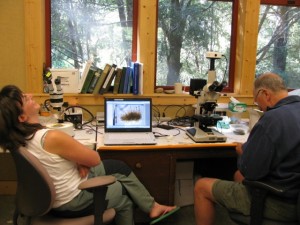
Dr. Paula Furey is an Associate Professor at the University of St. Catherine in Minneapolis, MN. Paula studies how abundances, health, and taxa of algae change over time and space. Of particular interest to her nitrogen-fixing algal species (cyanobacteria and diatoms in the family Rhopalodiaceae, which contain cyanobacterial endosymbionts), and how these shift in abundance and species composition seasonally, between different years, and down the drainage network from headwaters in to the main stem of the Eel River. Paula’s research highlights how hydrology, light, temperature, and foodweb interactions can alter species assemblage structure from edible, nutritious diatoms to less nutritious or hard to graze diatoms, or even toxin 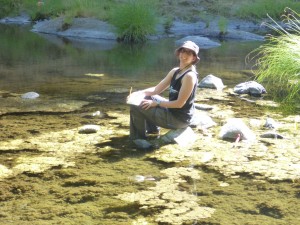 producing cyanobacteria. Her work on algae-midge interactions demonstrated that shifts in algal species composition caused by midge–algae interactions at small scales (um–m) could affect ecologically significant processes, such as nitrogen fixation and foodweb interactions at larger reach and watershed scales. She is developing a regionally relevant algal identification guide for use by researchers and local water-monitoring groups. Images taken at three scales (environmental context, macroscopic (what we’d see with the naked eye) and microscopic) will provide information key to identification.
producing cyanobacteria. Her work on algae-midge interactions demonstrated that shifts in algal species composition caused by midge–algae interactions at small scales (um–m) could affect ecologically significant processes, such as nitrogen fixation and foodweb interactions at larger reach and watershed scales. She is developing a regionally relevant algal identification guide for use by researchers and local water-monitoring groups. Images taken at three scales (environmental context, macroscopic (what we’d see with the naked eye) and microscopic) will provide information key to identification.
Algal Food Web Investigation Team (AFWIT)
Mary Power
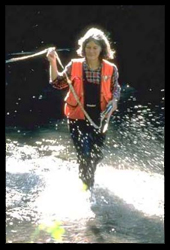
Our group studies food webs, which in our study areas are primarily fueled by attached algae. We are interested in how attributes and performances of algae and cyanobacteria, their invertebrate and vertebrate grazers, and predators of these grazers affect river, watershed, and coastal ocean ecosystems. We are particularly interested in how key species interactions change under different environmental regimes. To track this, we take advantage of Earth science research in and around our study sites in a “predictive mapping” approach, integrating across space and time to discover:
- Where and when ecological regimes change;
- Which factors cause these changes;
- How local landscape or seasonal controls are altered by changes in climate, land use or biota;
- how local interactions scale up to affect basinwide linkages of river, upland and coastal ecosystems.
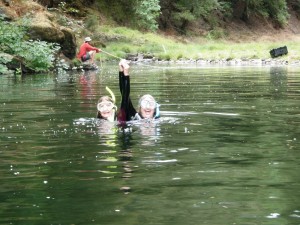
The surface area of rivers is small relative to the area of their watersheds; terrestrial plant biomass typically dwarfs that of aquatic primary producers; and gravity pulls material down slopes. For these reasons, it is oftenassumed that “forests feed their rivers”. Rapid growth and excellent nutritional quality of attached algae like diatoms, however, make them surprisingly important food sources, not only for aquatic consumers, but also for terrestrial biota like spiders, lizards, birds, and bats. We investigate process like insect emergence and algal stranding through which “the river feeds the forest”. We have recently also recently launched studies of linkages of the river to the ocean: examining the potential importance of riverine algal drift for consumers in estuaries; and whether algal-mediated biogeochemistry canaffect primary productivity in the coastal ocean near the river mouth. Mary Power is a Professor in the Department of Integrative Biology at Berkeley, and Faculty Director of the Angelo Coast Range Reserve.
